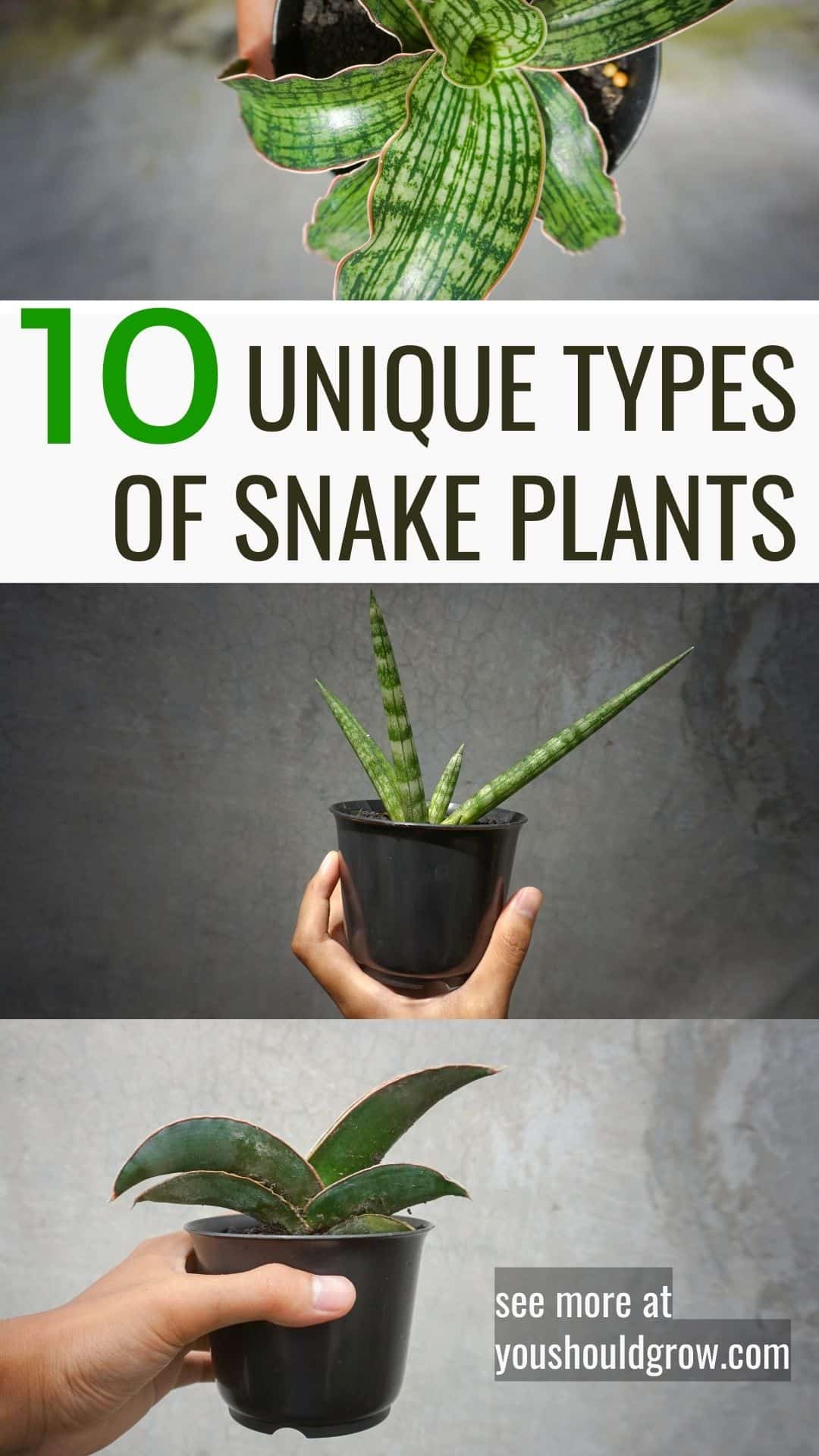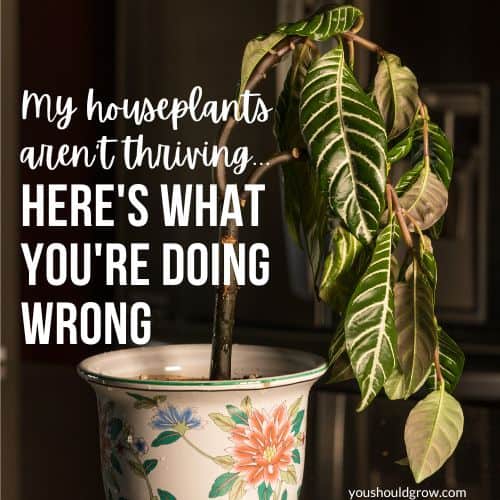10 Unique Snake Plant Varieties You’ll Want To Grow
As an Amazon Associate and member of other affiliate programs, I earn from qualifying purchases.
Snake plants are very popular with houseplant enthusiasts and for good reason. They’re quite easy to grow and tolerate a variety of lighting and watering conditions. We’re most familiar with the snake plant referred to as mother-in-law’s tongue. It has sturdy green foliage and is commonly between 3 inches and 3 feet tall.
It’s a fast-growing plant if given appropriate conditions, but in indoor conditions, it’s often kinda slow to grow. That’s because it is often placed in the least ideal location, but that’s what makes the plant itself ideal. It will tolerate almost any lighting situation you give it. It’s actually one of the hardest plants to kill.
So if you’re looking for something that will survive your black thumb, snake plants are a good choice.
Snake Plant Care
Lighting: Sansevieria like bright indirect light – unless you’ve acclimated it to something else. They will tolerate just about anything from direct sun to complete shade. Yep. You can put one of these in a bathroom with no windows, and it will be a long time before it will suffer from lack of light. It won’t grow, mind you, but it won’t die either. It will be quite satisfied if you move it to a bright location during spring and back to the bath for winter.
Water: here again you are in luck with the snake plant because it is very tolerant of neglect. In fact, you can let it dry out completely between waterings and it won’t batt an eye. It’s much less tolerant of overwatering, though. So err on the side of caution and if you think you should water it, maybe wait a week and then water it.
Soil: being susceptible to root rot, make sure you grow your snake plant in sandy, well-draining soil. You can use a regular potting mix with added sand or perlite or just grab a bag of cactus soil for this guy. Avoid something with a lot of peat as it will retain water and may lead to problems. However, if you bought a healthy plant from a well-maintained nursery, you likely won’t need to repot your snake plant any time soon.
Fertilizer: in spring to fall, you can fertilize once a month with a succulent formula if needed. Unless your plant is growing quickly, be careful not to overdo the plant food. Since it’s a slow grower, it doesn’t need a lot of extra nutrients. Hold off on fertilizer in the winter.
Native conditions: in the wild, snake plants will grow in zones 9 and up. It does not like cold weather at all. Temps as low as 50F can cause damage and a frost will cause it to leave this earth. So for most of us, our snake plants will need to remain indoors most of the time. You can move it outside in the summer, but be careful not to shock a plant that’s been in low light with a sudden burst of direct light. You will get leaf burn that way.
Snake Plant Varieties
There are over 70 different species of Sansevieria, also known as Snake Plant or Mother-in-Law’s Tongue, which are native to Africa, Asia, and the Middle East. These plants are known for their hardy nature and ability to thrive in a variety of environments making them popular choices for use as houseplants.
Dracaena trifasciata formerly Sansevieria trifasciata
The snake plant, Laurentii, is perhaps the most well-known and widely cultivated species of Snake Plant. It has long, upright, sword-like leaves that are green with distinctive silver or grey stripes running horizontally and sometimes yellow streaks vertically along the length of the leaves.

It’s a lovely houseplant and any indoor gardener would never turn one down. But if you want to get some different snake plant varieties (that are still easy to care for), have a look at these 10 unique snake plant varieties.
Sansevieria cylindrica – African Spear Plant
This species of Snake Plant is native to Angola and is characterized by its cylindrical leaves which are a deep green color. It is a slower-growing plant and is more drought-tolerant than some of the other species. It’s got a very interesting growth habit that can be left wild or braided for a more tamed aesthetic.
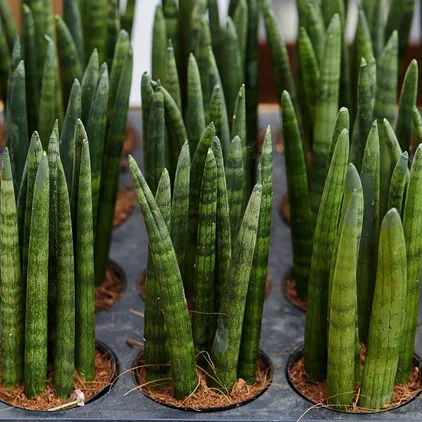
Whale Fin & Shark Fin
This species is native to West Africa and is characterized by its large, oval-shaped leaves which are a deep green color with lighter green or yellow stripes running along the length of the leaves. The big difference with the whale fin and shark fin varieties is that the leaves are very wide which makes them a very interesting houseplant especially when grown as a single specimen. It’s a minimalist, modern look that anyone can appreciate.
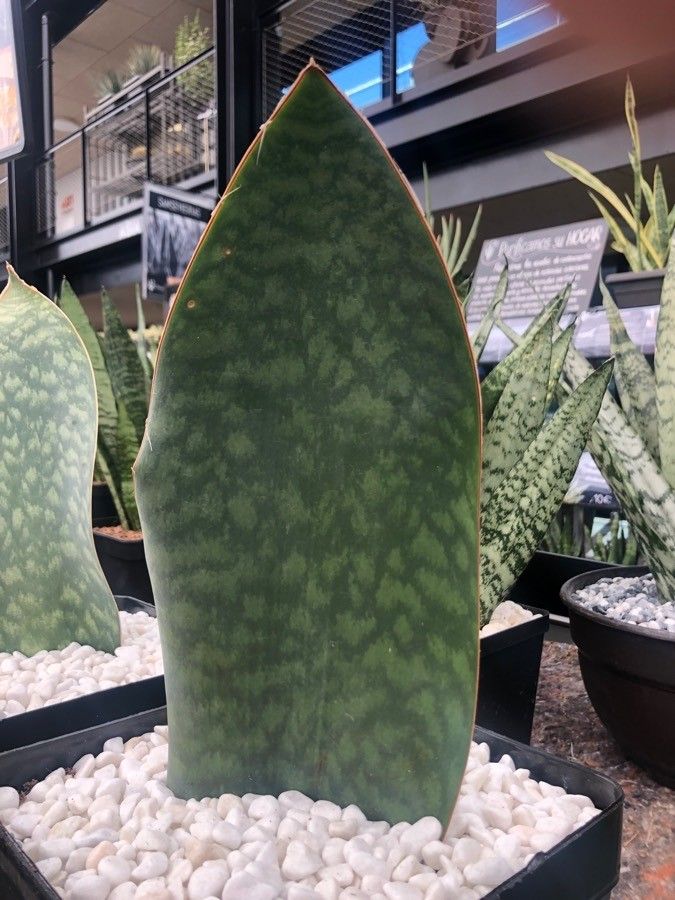
Blue Sansevieria aka Sansevieria ehrenbergii
With a striking growth pattern in the shape of a fan, you’ll love growing this unique snake plant. Another one of the cylindrical snake plant varieties, this one has such an interesting pattern of growth. In the right conditions this one can grow to be several feet long and wide so keep that in mind if it starts getting to big, you might want to propagate.

Sansevieria ‘Cleopatra’
Taking a break from the harsher lines of other snake plant varieties, Cleopatra has the sweetest scalloping along its leaves and a habit of growing in a rose pattern. This dwarf snake plant grows to about a foot tall, and if you see one in the store grab it. This is one of those rare snake plant varieties that are harder and harder to come by.

Sansevieria ballyi
Bursting with clusters of small plants, ballyi is a very interesting type of snake plant. Its cylindrical leaves grow in small rosettes making them a variety that is sometimes grown as a dwarf. However, if kept healthy dozens of the clusters can grow from the same plant making a wild and interesting living thing. Anyone else think they look like the shrimp hands from Beetlejuice?

Sansevieria Kirkii
Sansevieria kirkii is known for its long, scalloped leaves which are green with distinctive silver or grey stripes. Sansevieria kirkii is a good choice for use in indoor spaces because it remains small and can tolerate low light conditions. It is also said to purify the air by removing toxins, making it a popular choice for use in homes and offices.

Golden hahnii
This is a cultivar of Sansevieria trifasciata and is characterized by its small, compact size and short, narrow leaves which are green with distinctive yellow stripes. It’s also known as the bird’s nest snake plant because of it’s diminutive growth.

Sansevieria gracilis
This species is native to West Africa and is characterized by its narrow cylindrical leaves which are a light green color with darker green stripes running horizontally along the length of the leaves.

Tornado and Twister Snake Plant
If you’re looking for something with curves, you can’t go wrong with these two. Their dark green leaves twist and twirl earning them a name after the spinning winds of the midwest. A dwarf snake plant hybrid variety, the tornado and twister snake plants are great for bringing life and greenery into small spaces and offices. Twisted sister snake plant has a similar look.
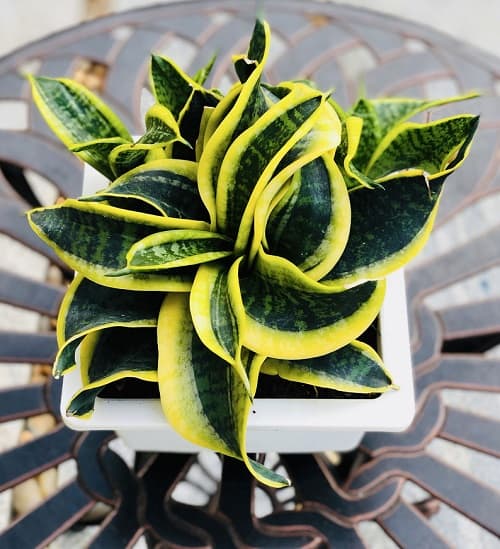
Moonshine
With a lovely sage green color, the moonshine snake plant is a pleasure to behold. It’s a nice break from the streaks and stripes of other snake plant colors. The silvery green color can be affected by lighting so if you notice your plant darkening up, give her a boost of light to encourage that paler sheen.

In addition to the above species, there are many other types of Snake Plants available for cultivation, including hybrids and cultivars. Some of these are more rare and may be difficult to find, while others are more widely available. Regardless of the specific type, Snake Plants are generally easy to care for and make great plants for both experienced gardeners and those who are new to plant care.
Propagating Snake Plants
Now that you have your favorite snake plants at home, you’ll be glad to know that they are quite easy to propagate. While you can also grow snake plants from seed, it’s slower and has a high failure rate. Fortunately taking leaf cuttings from snake plants is easy peasy.
- Cut a section off of a healthy leaf. Cutting into a point like the natural shape of the leaf helps to hide the scar and makes it easy to remember which end goes up. Lay it on a paper towel and set it aside for a day to let the cut end dry. This helps to prevent rot on the cut end.
- After it’s dried, dip the cut end in rooting hormone and place it into soil or water depending on how your preference. It will root well with either method. As far as soil, choose a well draining potting mix, like a succulent mix. If it’s in water, change the water every couple of days to a week. If it’s in soil, water it well and keep it slightly moist for a few weeks while it’s developing new roots.
- After a few weeks, you can repot your new snake plant into any container that pleases you.
Regardless of which method you choose, it is important to keep the soil moist (but not soggy) and to provide the young plants with plenty of light in order to encourage healthy growth. With proper care, your propagated Snake Plants should thrive and grow into healthy, mature plants.
How do I know when my snake plant needs to be repotted?
You won’t need to repot your snake plant very often. It is common to let them stay in the same pot for 2-3 years at a time…unless it’s growing rapidly and is showing signs of stress. Here are a few signs that may indicate that it is time to repot your Snake Plant:
- The plant is pot-bound – If you notice that the roots of your Snake Plant are growing out of the drainage holes in the bottom of the pot, or if you see roots visibly growing above the soil surface, it is likely time to repot the plant.
- The plant is overcrowded – If you have multiple Snake Plants growing in the same pot and they are starting to crowd each other, it may be time to repot them into separate pots to allow for proper growth.
- It starts to need water more often – plants that are severely root bound will use up water at an increased rate. If you’re finding that your plant is needing more frequent watering, check the roots to see if it’s rootbound and repot if needed.
In general, the best time to repot houseplants is in the spring when the plant is just starting to come out of its dormant period. This will give the plant plenty of time to adjust to its new pot and soil before the growing season begins. When repotting a Snake Plant, choose a pot that is one size larger than the original pot. Make sure it has drainage holes and use a well-draining cactus mix to minimize the risk of root rot.
What’s wrong with my snake plant?
There are a few common problems that people may encounter when growing Snake Plants (Sansevieria), including the following:
Yellowing leaves – One of the most common problems with Snake Plants is yellowing leaves. This is most frequently caused by over-watering or possibly a lack of sunlight. If your plant’s leaves are yellowing, the first thing to do is check the moisture level of the soil. If it’s soggy and has a bad odor, get that baby out of there asap. Take a look at all the roots and remove anything slimy and black then repot in fresh soil and don’t overwater it. If you do happen to overwater your snake plant, you can move it to an area with more light. Increased light will encourage it to use up the water in the soil more quickly.
Drooping leaves – If the leaves of your Snake Plant start to wilt or droop, it could be a sign that the plant is getting too much water or not enough light. Alternatively, if the soil is loose and unsupportive, the plant can sag or fall over. Make sure you have filled your snake plant’s pot with quality, well draining soil.
Brown tips on leaves – If the tips of the leaves on your Snake Plant start to turn brown, it could be a sign of over-watering or under-watering. Make sure you are watering the plant consistently and that the soil is well-draining to prevent this problem.
Make sure to address any issues as soon as they arise. Plants undergoing stress are more likely to get infested with houseplant pests.
Common houseplant pests on snake plants
Like any plant, Snake Plants (Sansevieria) can occasionally be susceptible to pests. Some common pests that may affect Snake Plants include mealybugs, aphids, and spider mites. Mealybugs are small, white, cottony insects that feed on the sap of the plant and can cause leaves to yellow and wilt. Aphids are small, green or black insects that feed on the sap of the plant and can cause leaves to curl and become distorted. Spider mites are tiny, spider-like insects that feed on the sap of the plant and can cause leaves to yellow and become mottled.
If you notice any of these pests on your Snake Plant, there are a few steps you can take to control them:
- Isolate the affected plant – If you have multiple plants, it is a good idea to isolate the affected plant to prevent the pests from spreading to other plants.
- Remove the pests – If the infestation is small, you may be able to remove the pests by spraying your plant with water or place a sticky fly trap if they’re flying insects.
- Use a pesticide – If the infestation is more severe, you may need to use a pesticide to control the pests. There are many different pesticides available for use on houseplants, but many minor infestations can be controlled with organic neem oil solutions.
It is also a good idea to practice good cultural care to help prevent pests from becoming a problem. This includes keeping the plant well-watered and fertilized, and providing it with proper lighting and ventilation. By following these simple steps, you can help to keep your Snake Plant healthy and pest-free.
Do all types of snake plants clean the air?
One of the most interesting things about Snake Plants (Sansevieria) is their ability to purify the air by removing toxins. These plants are said to be able to absorb toxins such as formaldehyde, benzene, and trichloroethylene from the air, making them a recommended choice for use in homes and offices. In fact, a study conducted by NASA found that Snake Plants are among the most effective plants at removing toxins from the air and improving indoor air quality.
Are snake plants poisonous to pets?
Technically, yes. Snake plants are poisonous to people and pets, so it is not recommended to eat them. Symptoms of poisoning can vary from mild gastrointestinal upset (vomiting and diarrhea) to numbness and swelling of the mouth and throat. If you’re concerned about snake plant poisoning, please see a medical professional immediately.
Overall snake plants are excellent choices for novice and experienced indoor gardeners. You can hardly kill them, they’re so generous and forgiving. Just make sure you don’t OVER water and you should be able to enjoy all these snake plant varieties and benefits for many years.


